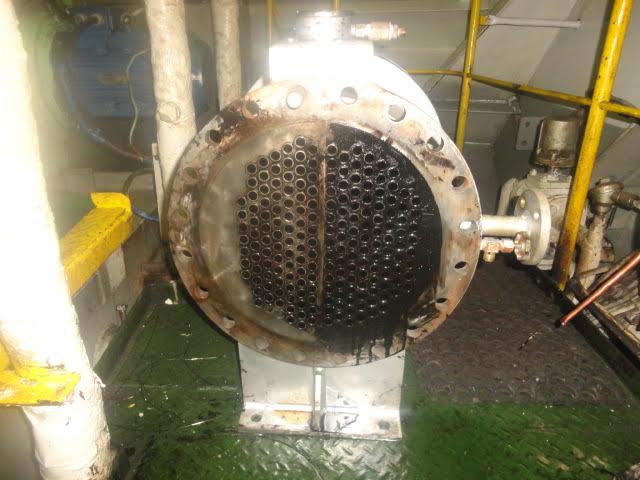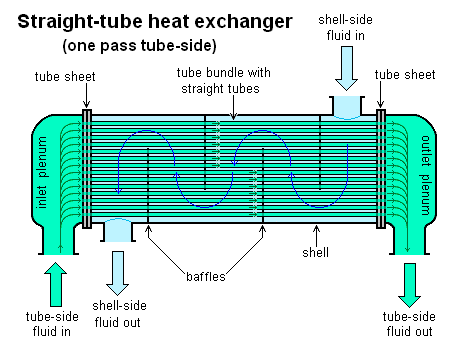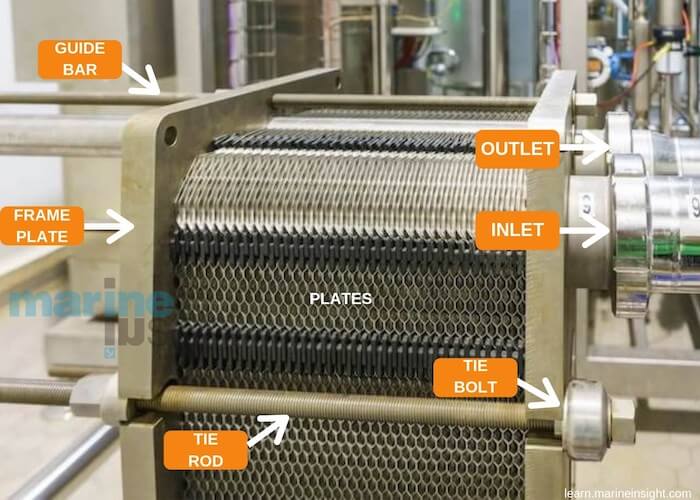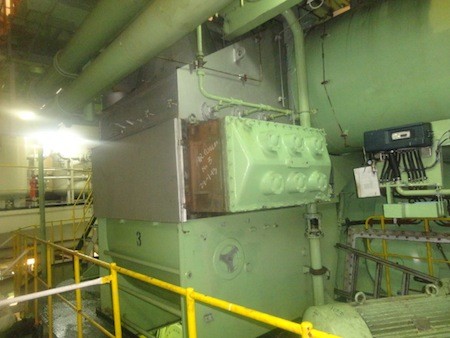Types of Heat Exchangers on a Ship
Different types of heat exchangers are used onboard a ship. The type of heat exchanger used for a particular usage depends on the application and requirement. Almost all the systems onboard ship depends on heat exchanger where the fluid is either cooled or heated.
The types of exchangers are mainly defined by their construction and are as follows:
1) Shell and Tube Type Heat Exchanger
This is the most popular type design with a shell accompanying several tubes and the flow of liquid to be cooled is mainly through tubes, whereas the secondary liquid flows over the tube inside the shell.
Shell and tube type heat exchanger is extremely economical to install and easy to clean; however, the frequency of maintenance is higher than other types.
In this heat exchanger, the complete shell is fitted with a tube stack or commonly known as the shell. There are two end plates which are sealed on both the sides of the shell and a provision is made at one end to cater for the expansion. The cooling liquid passes through the tubes which are sealed on either end into the tube plate. The tubes are secured in the tube plate by bell mouthing and expansion.
Related Read: How to do Maintenance of Marine Heat Exchangers on Ships?
The shell is enclosed with water chambers which surround the tube plates completely. The coolers could either be single pass or double pass exhibiting the flow of cooling liquid.
Gaskets are fitted between the tube plates and the shell; similarly, between the tube plate and the end cover to cater to the leakages from the cooler.
The other side of the tube plate, which is not fixed is free to move and has seals on either side of a safety expansion ring. The cooling liquid or the liquid to be cooled could then leak out and will hence be visible preventing any intermixing or contamination.
The main engine cooling freshwater cooler and the main engine lube oil cooler have conventionally been circulated with seawater, which apparently passes through the tubes of the cooler.
Related Read: General Overview of Central Cooling System on Ships
The shell, on the contrary, is in contact with the liquid being cooled, mainly lub. oil or distilled freshwater with corrosion-inhibiting chemicals which are added directly to the expansion tanks to keep a think protective layer inside the pipelines, thus preventing corrosion. Drew marine offers Liquidewt and Unitor provides Rocor NB liquid, which is generally used for corrosion inhibition. The shell could be of cast iron or steel. It is recommended that the coolers are installed vertically to ensure the automatic venting of the air from the system, as the airlock causes excessive overheating and will reduce the effective cooling surface area of the liquid being cooled.
Baffles are fitted on the tube bundle which lead the liquid to be cooled up and down, thus increasing the effective surface area of cooling. They also support the tubes, providing strength and rigidity to the bundle.
Aluminium brass is generally used for the construction of the tubes which is 76% copper; 22% zinc and 2% aluminium.
Sacrificial anodes are used in the seawater side for corrosion prevention as they corrode first and prevent the material with seawater being the electrolyte.
The tubes could fail prematurely as the water could be polluted in coastal areas or because of excessive turbulence due to seawater flow rates. The water impinges at a high velocity and hence could fail the tubes. Thus, the velocity of seawater should be kept below 2.5 m/s in case of aluminium brass. A little turbulence is required which eventually reduces the silting and settlement in the tubes.
Operation Of Shell & Tube Type Cooler
- A leak test of the piping is supposed to be carried out before the shell and tube type cooler is used for the actual operation. The cooling liquid and the liquid to be cooled should be circulated, flushed and checked for leakages.
- It is generally advised to run clean cooling fluid in the tubes during the initial phase of circulation as the debris can erode the protective layer in the tubes. The seawater inlet and outlet valves are kept fully open generally but the liquid to be cooled could be bypassed if needed by a three-way temperature control valve.
- Vents are provided on either side of the medium, mainly the cooling liquid and the liquid to be cooled. The vents should be opened first after the initial circulation of fluids or after maintenance to purge off the air which could increase the temperature difference considerably.
- Drain plugs are mounted in the coolers at the lowest points so as to drain the cooler completely while maintenance. Single-pass, vertically mounted coolers will ensure automatic venting but with the horizontally mounted coolers the inlet cooling water branch should be faced downwards and the outlet water should be faced upwards for automatic venting of the air.
Related Read: Heat Exchangers on Ship Explained
Maintenance Of Shell & Tube Type Cooler
Observing safety measures, the fluids should be isolated completely and the cooler should then be opened up.
- The heat transfer surfaces should be cleaned properly which is the basis for the satisfactory operation of the shell and tube type cooler. The seawater fouls the cooling surfaces because of plant and animal growth, which is indicated by the increase in temperature difference between the cooling and the liquid being cooled. Further, the pressure changes will indicate the same
- Excessive corrosion can result in the leakage of tubes. The leakage could be determined by the following method:
- Discharge the liquid being cooled in the liquid chamber by the drain valve provided in the bottom and open up the chamber.
-
- Fill the main body with fresh water and pressurize it by applying air pressure or hydraulic pressure from the top. The connection could be fitted, if not given
-
- The leaking tube could then be identified when completely dried up
-
- If the leakage happens from the expansion part of the tube in the tube plate, then it could be expanded slightly, which could arrest the leakage
-
- The leaking tube could then be plugged from both sides by wooden plugs provided by the manufacturer or could be made as well
-
- The leaking tube could be replaced as well, depending on its condition
-
- The leaking tube could be removed by making a bore inside the tube with a drill or a reamer of 0.5mm smaller than the outside diameter of the tube to a depth of the expansion
-
- Then the tube drawing tool could be inserted and tapped slowly to knock it out from the other end
-
- The new tube could be installed by inserting the tube expander to both sides of the tube and expanding it
-
- Wall thickness of reduction= (wall thickness of tube before expansion – wall thickness of tube after expansion) / wall thickness of tube before expansion X100%
-
- The above value should be between 5-8%
2) Plate Type Heat Exchanger
Plate type exchanger consists of thin corrugated plates joined parallel together, creating a cavity for fluid flow inside it. Alternate sides of the plate carry two different fluids, between which, heat transfer is carried out.
Installation of this type of heat exchanger is expensive than shell and tube type, but the maintenance cost is much lower.
The efficiency of plate type is higher than shell and tube type for the same size of the unit and can withstand high pressure.
The plate type coolers can be opened up easily for cleaning and are thus convenient to install and clean as minimum space is required for their installation.
They’re highly efficient than the shell and tube type coolers of the same size and the same capacity.
They are made up of similar metal plates which have a patterned corrugation and are sealed from each other by nitrile rubber joints.
The first and last plates also called as innermost and the outermost plates are held together by the frames on either side and further set in place by the tie bolts.
Four branch pipes on the pressure plate, align with ports in the plates through which two fluids pass. Seals around the ports are so arranged that one fluid flows in alternate passages between plates and usually in opposite direction.
The plate corrugations promote turbulence in the flow of both fluids and so encourage efficient heat transfer. Turbulence, as opposed to smooth flow, causes more liquid to pass between the plates and to come into contact with them.
It also breaks up the boundary layer of liquid which tends to adhere to the metal and act as a heat barrier when the flow is slow.
The corrugations make the plates stiff so permitting the use of thin material. They additionally increase the plate area as well. Both of these factors contribute to heat exchange efficiency.
Excessive turbulence can cause the erosion of the plate material and hence moderate flow rates must be incorporated. Titanium plates though expensive are generally used as they have the best resistance to corrosion and erosion. The rubber seals between the plates are bonded to the plate surfaces by the special adhesives and removed by acetone, if available.
The rubber seals are not suitable for extremely high temperatures as they lose their elasticity and harden becoming brittle and eventually break when the cooler is opened up for cleaning and inspection. The rubber joints get squeezed properly when they’re tightened by the clamping bolts and hence provide a good sealing therein.
The length of the tie bolts should be measured correctly before opening the plate type cooler for maintenance and inspection as over-tightening the plates can bend them completely and render them useless and could be expensive. Under tightening can cause the plates to leak. Thus, the tie bolts should be tightened with the correct torque as mentioned in the instruction manual.
Plate type coolers are very expensive because of the titanium plates but their low maintenance and the low operation cost outweigh them being so expensive.
Repair Of Plate Type Cooler
When the plate type coolers are opened up for inspection they should be checked properly for holes as they could leak later. Further, the joints should be checked for their sealing surfaces and pasting as well.
These type of coolers have a filter in the sea water side, which should be opened up regularly for the removal of debris, which apparently can cause the joints to leak and also reduce the effecting heat transfer area.
If the coolers are to be put out of service for long periods then the seawater side should be drained completely, flushed with fresh water and then dried to be used again.
3) Plate Fin Heat Exchanger
Plate and fin type heat exchanger is constructed similar to a plate-type exchanger but also contains fins to increase the efficiency of the system. Aluminium alloy is used as it gives higher heat transfer efficiency and lowers the weight of the unit.
Fins can be fixed in perpendicular to the direction of flow and are known as offset fins. Fins fixed in parallel to the direction of flow are straight fins. Fins can be fixed in curvature form to increase the heat exchanging effect and are thus known as wavy fins. The efficiency of this heat exchanger is slightly higher than plate type unit but installation and maintenance cost is higher.
Related Read: Energy Efficiency Management in the Maritime Industry
4) Dynamic Scrapped Surface Heat Exchanger
In this heat exchanger because of the continuous scrapping of the surface long running time is achieved which helps in better heat transfer efficiency and decrease in the fouling of the system.
The scrapping is done by a blade unit operated by a motor-driven shaft with timer moving inside the frame. This heat exchanger is normally used for heat transfer of highly viscous fluid by increasing the turbulence of the fluid. Maintenance cost is less as compared to other types because of the auto cleaning process.
5) Phase Change Heat Exchanger
As the name suggests, this type of heat exchanger is used to change the phase of a medium from solid to liquid or liquid to a gas by the principle of heat transfer. This type is normally operated in freeze cycle and melts cycle for change in phase to happen.
The heat exchanger is normally constructed like a shell and tube type exchanger but consists of at least two divider walls to construct upper and lower annular space for flow passage. It also consists of fins in both passageways for efficient heat transfer.
6) Spiral Heat Exchanger
This type of heat exchanger consists of concentric shape flow passages which help in creating a turbulence flow of a fluid which in turns increases the heat transfer efficiency. Initial installation cost is higher but highly efficient as compare to other types as space-saving is much more because of the compact size. Maintenance cost is lowest as compared to other types for the same size of the unit.
The Flow of fluid in spiral type is rotary current flow which itself possesses the property of self-cleaning of fouling inside the spiral body.
7) Direct Contact Heat Exchanger
In this type of heat exchanger, there is no separating wall inside the unit. Both the mediums are in direct contact for the heat transfer process.
Direct contact type heat exchangers can be further classified as
1. Gas-liquid
2. Immiscible liquid-liquid
3. Solid-liquid or solid-gas
Charge Air Cooler
- The charge air coolers or commonly known as air coolers are fitted after the turbochargers to decrease the temperature of the air before it enters the engine cylinder.
- The charge air coolers are provided with fins to increase the heat transfer surface as the air itself has poor heat transfer properties.
- Solid drawn tubes are passed through the thin copper fin plates and are bonded by soldering for maximum heat transfer. The ends of the tubes are fixed in the tube plates by expanding and soldering the tubes.
- The air is cooled to its dew point temperature so that the moisture content in the air is removed by precipitation as the water content will cause sulphur corrosion if it enters the engine cylinder. The condensation goes to the air cooler tank if fitted else goes to the bilge well directly
Related Read: 10 Points for Efficient Turbocharger Operation On Ships
Inter or After Cooler (For Air Compressors)
- These type of coolers are very similar to the charge air coolers as their function is to reduce the temperature of the air to its dew point temperature and eventually precipitate moisture which might enter the compressor cylinder.
- These type of coolers are fitted with pockets and drain valves for removal of moisture and oil.
- These type of coolers might be special U tube coolers with copper tubes as they occupy very less space and form an integral part of the air compressor. These coolers are called coil coolers as well.
- They are generally used for high-pressure applications. They’re expensive and difficult to clean.
- They have low heat transfer efficiency due to the large tube diameter.
- The copper tubes could be brazed if they start leaking or could be plugged as per the convenience.
Related Read: Efficiency of Air Compressor and Uses of Compressed Air on a Ship
Disclaimer: The authors’ views expressed in this article do not necessarily reflect the views of Marine Insight. Data and charts, if used, in the article have been sourced from available information and have not been authenticated by any statutory authority. The author and Marine Insight do not claim it to be accurate nor accept any responsibility for the same. The views constitute only the opinions and do not constitute any guidelines or recommendation on any course of action to be followed by the reader.
The article or images cannot be reproduced, copied, shared or used in any form without the permission of the author and Marine Insight.
Do you have info to share with us ? Suggest a correction

About Author
An ardent sailor and a techie, Anish Wankhede has voyaged on a number of ships as a marine engineer officer. He loves multitasking, networking, and troubleshooting. He is the one behind the unique creativity and aesthetics at Marine Insight.
Subscribe To Our Newsletters
By subscribing, you agree to our Privacy Policy and may receive occasional deal communications; you can unsubscribe anytime.










Dear Mr. Anish,
The article is very well explained the different type of HXs in the ship.
I have a query regarding the Design of Shell & Tube Heat Exchanger with integral expansion tank. In that connection i would like to know more about the role of expansion tank.
Thanks